最新人教版新目标七年级下unit3教案
- 格式:docx
- 大小:24.92 KB
- 文档页数:12
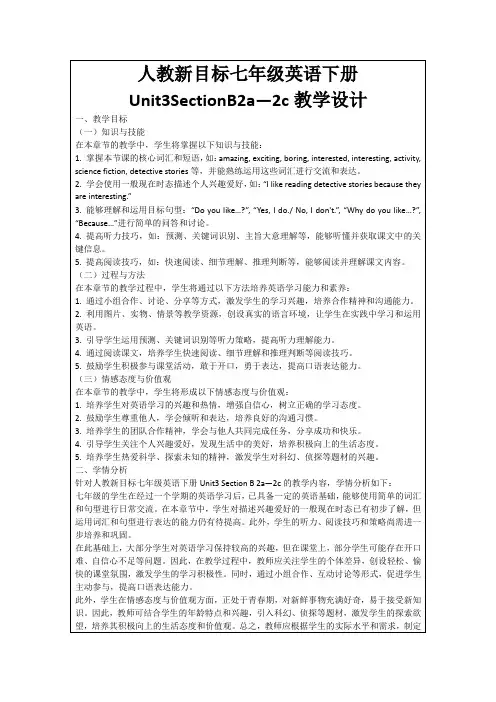
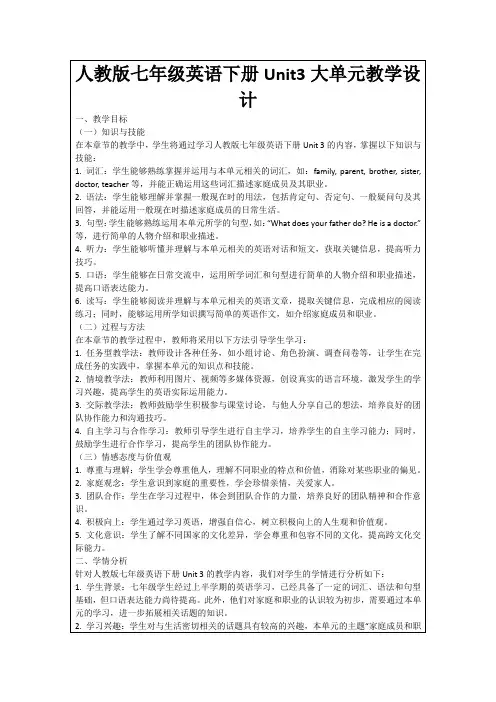
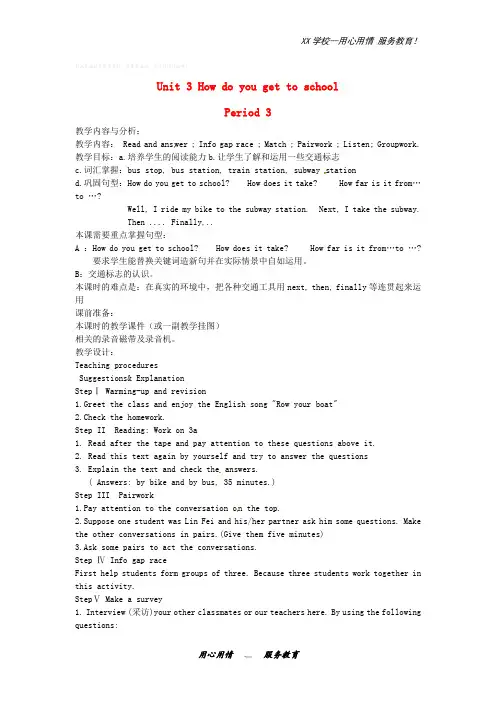
精品基础教育教学资料,请参考使用,祝你取得好成绩!Unit 3 How do you get to schoolPeriod 3教学内容与分析:教学内容: Read and ans wer ; Info gap race ; Match ; Pairwork ; Listen; Groupwork. 教学目标:a.培养学生的阅读能力b.让学生了解和运用一些交通标志c.词汇掌握:bus stop, bus station, train station, subway stationd.巩固句型:How do you get to school? How does it take? How far is it from…to …?Well, I ride my bike to the subway station. Next, I take the subway. Then .... Finally,..本课需要重点掌握句型:A :How do you get to school? How does it take? How far is it from…to …?要求学生能替换关键词造新句并在实际情景中自如运用。
B:交通标志的认识。
本课时的难点是:在真实的环境中,把各种交通工具用next, then, finally等连贯起来运用课前准备:本课时的教学课件(或一副教学挂图)相关的录音磁带及录音机。
教学设计:Teaching proceduresSuggestions& ExplanationStepⅠ Warming-up and revision1.Greet the class and enjoy the English song "Row your boat"2.Check the homework.Step II Reading: Work on 3a1. Read after the tape and pay attention to these questions above it.2. Read this text again by yourself and try to answer the questions3. Explain the text and check the answers.( Answers: by bike and by bus, 35 minutes.)Step III Pairwork1.Pay attention to the conversation o n the top.2.Suppose one student was Lin Fei and his/her partner ask him some questions. Make the other conversations in pairs.(Give them five minutes)3.Ask some pairs to act the conversations.Step Ⅳ Info gap raceFirst help students form groups of three. Because three students work together in this activity.StepⅤ Make a survey1. Interview (采访)your other classmates or our teachers here. By using the following questions:How do you get to school?How far is it from your home to school?How long does it take ?2. Report:Peter's home is about … kilometers far from school. He walks to school. It takes him about ten minutes….Step VI Presentation (Section B 1a)Show some pictures on the screen. Teach students some key words.Say something about the pictures one by one.For example:This is a train station. Trains stop here.This is a bus stop. Buses stop here.This is a subway station.This is a bus station.(Ask students to repeat these words.)(This activity int roduces more key vocabulary.)Step Ⅶ Ro le play ( Work on 1b)1. First ask two students to read the dialogue to the class.Sa: How do you get to school?Sb: Well, I ride my bike to th e subway station. Then I take the subway.Step Ⅷ Listening1. Work on 2a(1) First ask students to read the list of informationthat Thomas w ants to know.…where Nina lives.…how far from school she lives.…how long it takes to get to school.…how she gets to school.…what she thinks of the transportation.(2) Tell students what transportation and bus stop mean.bus stop汽车站 transportation n. 运送;运输Then tell students we'll hear a recording. Please put a checkmark in front of each thing that Thomas wants to know.(3) Now play the recording for students.(Have students pay attention to the sample answer.)(4) Then correct the answers.2. Work on 2bShow two sets of pictures on the screen.( Answers: Picture 2 should be checked. )Step Ⅸ Groupwork ( Work on 2c)In this activity let students tell how Nina gets to school. Ask students to use the pictures in 2b. And write these sentences on the board.First she …. Next s he …. Then she …. 教学反思。
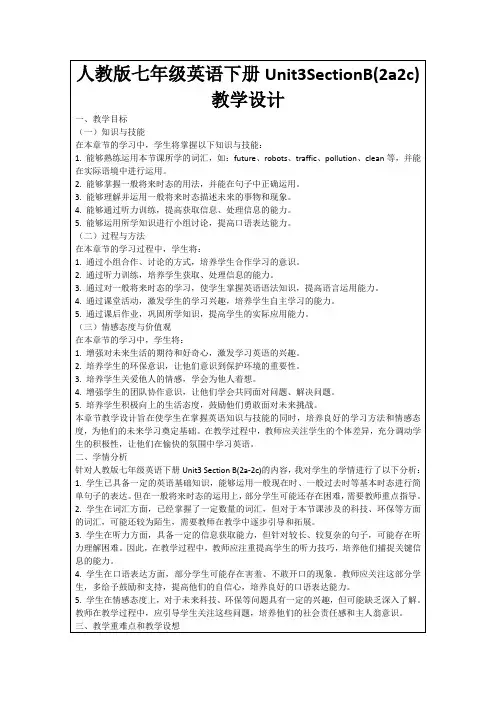

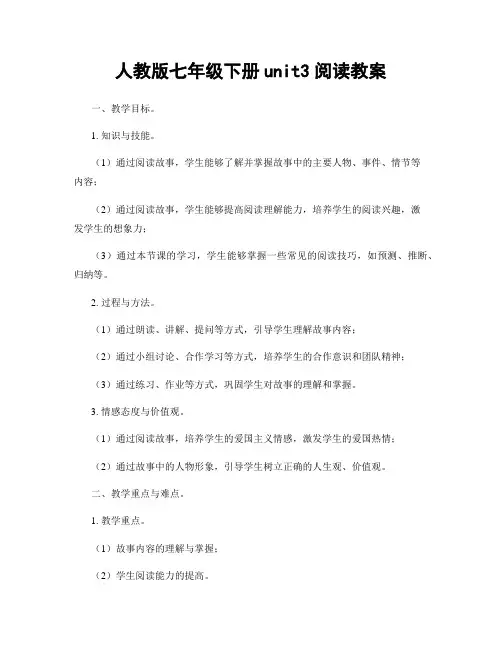
人教版七年级下册unit3阅读教案一、教学目标。
1. 知识与技能。
(1)通过阅读故事,学生能够了解并掌握故事中的主要人物、事件、情节等内容;(2)通过阅读故事,学生能够提高阅读理解能力,培养学生的阅读兴趣,激发学生的想象力;(3)通过本节课的学习,学生能够掌握一些常见的阅读技巧,如预测、推断、归纳等。
2. 过程与方法。
(1)通过朗读、讲解、提问等方式,引导学生理解故事内容;(2)通过小组讨论、合作学习等方式,培养学生的合作意识和团队精神;(3)通过练习、作业等方式,巩固学生对故事的理解和掌握。
3. 情感态度与价值观。
(1)通过阅读故事,培养学生的爱国主义情感,激发学生的爱国热情;(2)通过故事中的人物形象,引导学生树立正确的人生观、价值观。
二、教学重点与难点。
1. 教学重点。
(1)故事内容的理解与掌握;(2)学生阅读能力的提高。
2. 教学难点。
(1)培养学生的阅读兴趣;(2)引导学生进行深层次的阅读理解。
三、教学过程。
1. 导入新课。
通过谈论一些与故事有关的话题,引起学生的兴趣,如“你喜欢听故事吗?为什么?”、“你最喜欢的故事是什么?为什么?”等。
2. 阅读故事。
(1)教师朗读故事,学生跟读;(2)教师讲解故事中的生词、短语等;(3)学生分组讨论故事中的主要人物、事件、情节等内容;(4)学生展示小组讨论成果,进行互动交流。
3. 操作练习。
(1)学生个人完成故事相关的练习题,如选择题、判断题等;(2)学生交流答案,订正错误。
4. 拓展延伸。
(1)教师提出一些与故事相关的问题,引导学生进行深层次的思考和讨论;(2)学生进行小组合作,展示他们对故事的理解和想法;(3)学生进行个人总结,写下对故事的感想。
5. 作业布置。
布置阅读相关的作业,如写一篇关于故事的读后感,或者选择一段故事进行朗读等。
四、教学反思。
本节课通过故事的阅读,引发学生的阅读兴趣,培养学生的阅读能力,同时也培养了学生的合作意识和团队精神。
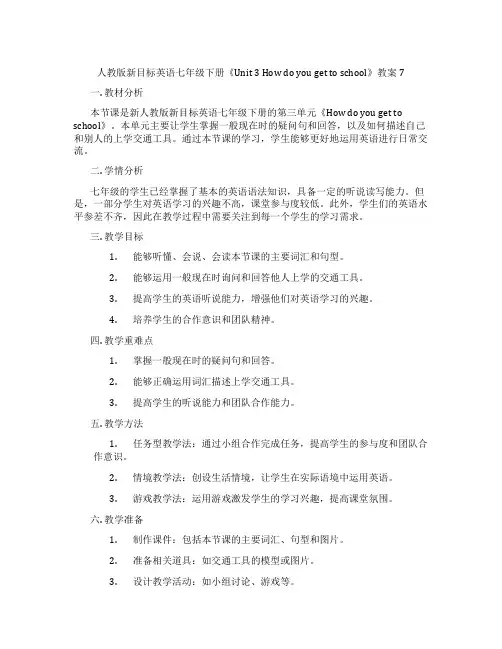
人教版新目标英语七年级下册《Unit 3 How do you get to school》教案7一. 教材分析本节课是新人教版新目标英语七年级下册的第三单元《How do you get to school》。
本单元主要让学生掌握一般现在时的疑问句和回答,以及如何描述自己和别人的上学交通工具。
通过本节课的学习,学生能够更好地运用英语进行日常交流。
二. 学情分析七年级的学生已经掌握了基本的英语语法知识,具备一定的听说读写能力。
但是,一部分学生对英语学习的兴趣不高,课堂参与度较低。
此外,学生们的英语水平参差不齐,因此在教学过程中需要关注到每一个学生的学习需求。
三. 教学目标1.能够听懂、会说、会读本节课的主要词汇和句型。
2.能够运用一般现在时询问和回答他人上学的交通工具。
3.提高学生的英语听说能力,增强他们对英语学习的兴趣。
4.培养学生的合作意识和团队精神。
四. 教学重难点1.掌握一般现在时的疑问句和回答。
2.能够正确运用词汇描述上学交通工具。
3.提高学生的听说能力和团队合作能力。
五. 教学方法1.任务型教学法:通过小组合作完成任务,提高学生的参与度和团队合作意识。
2.情境教学法:创设生活情境,让学生在实际语境中运用英语。
3.游戏教学法:运用游戏激发学生的学习兴趣,提高课堂氛围。
六. 教学准备1.制作课件:包括本节课的主要词汇、句型和图片。
2.准备相关道具:如交通工具的模型或图片。
3.设计教学活动:如小组讨论、游戏等。
七. 教学过程1.导入(5分钟)利用多媒体展示各种交通工具的图片,引导学生谈论自己上学的方式。
教师通过提问激发学生的兴趣,如:“How do you usually go to school?”学生回答后,教师简要介绍本节课的内容。
2.呈现(10分钟)教师展示本节课的主要词汇和句型,如:“I go to school by bus.”学生跟读并模仿,教师给予表扬和鼓励。
3.操练(10分钟)学生分组,每组选择一种交通工具,用英语描述自己的上学方式。
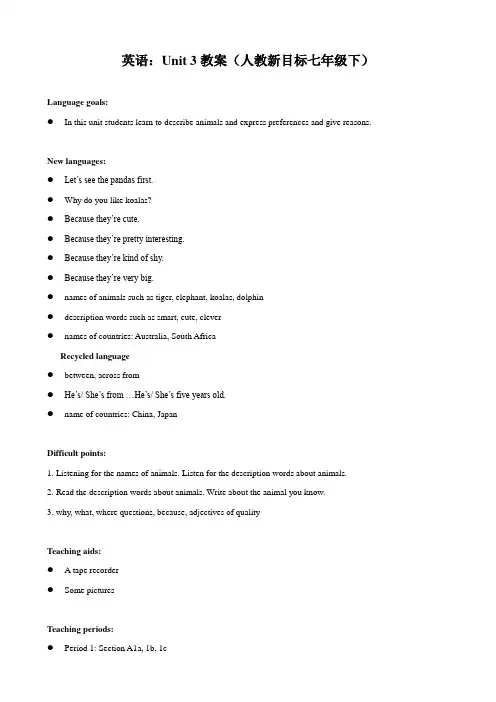
英语:Unit 3教案(人教新目标七年级下)Language goals:●In this unit students learn to describe animals and express preferences and give reasons.New languages:●Let’s see the pandas first.●Why do you like koalas?●Because they’re cute.●Because they’re pretty interesting.●Because they’re kind of shy.●Because they’re very big.●names of animals such as tiger, elephant, koalas, dolphin●description words such as smart, cute, clever●names of countries: Australia, South AfricaRecycled language●between, across from●He’s/ She’s from …He’s/ She’s five years old.●name of countries: China, JapanDifficult points:1. Listening for the names of animals. Listen for the description words about animals.2. Read the description words about animals. Write about the animal you know.3. why, what, where questions, because, adjectives of qualityTeaching aids:● A tape recorder●Some picturesTeaching periods:●Period 1: Section A1a, 1b, 1c●Period 2: Section A2a, 2b, 2c●Period 3: Section A3a, 3b, 4●Period 4: Section B 1, 2a, 2b, 3●Period 5: Section B 3a, 3b, 3c, 4●Period 6: Self CheckPeriod 1Teaching aims:1. Teach vocabulary words.2. Target languages:Let’s see the pandas.Why do you want to see the lions?Because they’re cute.3. Enable the students to talk about animals.4. Help the students learn how to listen to and talk about animals.Teaching procedures:Step 1. Warming upTalk about animals using pictures.Teach new words about animals by the pictures.Step 2.Match work (1a)Ask the students to read the words and the picture, and then match the names with the pictures a–h.Encourage or help the students to say something about the picture and do the match work.Step 3. Listening (1b)Point to the numbered list of words in activity 1a and play the recording. Ask the students to listen to the recording and circle the countries in 1a.Play the tape and then check the answers.Ask the students to listen to and repeat after the recording and then check the answers.Further activity: Ask the students to do some pair work in the following way if they can understand thelistening material well.Step 4. Pair work (1c)Ask the students to make conversations in pairs.Show the following.—Let’s see the pandas / giraffes / lions / penguins / dolphins / koalas /elephants / tigers?—Why?—Because they’re cute / interesting / fun / interesting / smart.Say: Now please make conversations in pairs, using the animals in activity 1a and the description words in activity 1c.Homework1. Ask the students to remember the new words in this period (on page 116) by heart.2. Ask the students to practice the conversation in activity 1c.Period 2Teaching aims:1. Learn the vocabulary words and useful expressions.2. Target languages:I like dolphins.Why do you like dolphins?Because they are kind of interesting.3. Enable the students to talk about animals and tell why they like them.4. Help the students learn to talk about animals and tell why they like them.Teaching procedures:Teaching procedures:Step 1. Free talk and lead-inRevise the names of the animals.Say: In last period we learnt the names of some animals. Now let’s do some revision. Please look at the pictures one by one and you have to tell me the name of the animal in the picture. OK?Show the students the animal pictures one by one.Revise the conversation learnt in the last period.Give more chances to more students to practice talking about the animals and expressing why they like the animals.Step 2. Listening (2a, 2b)First ask the students to listen and fill in the chart in activity 2a.Play the recording for the first time. Ask the students to listen carefully and write down the animals.Play the tape the second time.Ask the students to pay attention to the words in the box in Activity 2b.Ask the students to pay attention to the conversation in activity 2b.After that, check the answers.Then ask the students to listen to and repeat the dialogue after the recording.After this, ask the students to practice the conversation without the help of the recording.Step 3. Pair work (2c)Ask the students to work in pairs, ask and answer about animals they know.Ask the students to practice: Why? Because they are…Step 4.GrammarfocusAsk the students to read the sentences in the grammar box and sum up the sentence structure.Practice suggestion: Ask the students to work in groups and write down their own opinions on the animals in Activity 1a on a piece of paper; show their work to the group members. And then ask and answer questions.HomeworkAsk the students to do the following:1. Make similar dialogues according to the conversation in 2c.2. Use the words in the box in activity 2b to make sentences.3. Ask the students to find more description words about animals.Period 3Teaching aims:1. Teach vocabulary words.2. Target languages:Where are lions from?Lions are from South Africa.3. Enable the students to say where some animal are from.4. Help the students to say where some animals are from.Teaching procedures:Step 1. Free talk and lead-inShow the students some pictures and ask some questions.Show the first picture with a panda in it.Show other pictures of animals and ask questions and go on with others in the same way.Step 2.Match work (3a)Ask the students to read the maps and the animals in activity 3a.Let the students look at the three animals.Let the students match the countries and the animals.Move around the classroom to see if the students need help.Ask the students to draw lines to match the maps with the pictures.Step 3. Pair work(3b)Ask the students to read the conversation in activity 3b.Ask the students to work in pairs and ask and answer questions.Step 4. GameAsk the students to read the list of countries and animals.Let the students look at the list of countries and animals and find a person to translate the list of countries and animals into Chinese.Show the students how to play the game.Play the recording for the first time.Play the recording again and check the answers by replaying the tape.HomeworkAsk the students to practice talking about where animals come from in Activity 3a.Period 4Teaching aims:1. Teach vocabulary words.2. Target languages:What animals do you like?I like elephants.3. Enable the students to talk about why they like some animals.4. Help the students to learn how to talk about why they like some animals.Teaching procedures:Step 1. Warming and lead-inCheck the homework by asking some questions.Show the pictures of lions, pandas and koalas.Say: Where are pandas from? Where are koalas from? Where are lions from?Show a picture of a big elephant.Step 2.Match work(1)Ask the students to read the words and the picture, and then match the names with the pictures a–h.Point to the pictures one by one.Ask the students to read the eight numbered adjectives at the top.Ask the students to do the match work.Step 3. Listening (2a, 2b)Point to the numbered list of words in activity 1 and play the recording. Askthe students to listen to the recording and circle the description words inactivity 1.Play the tape for the first time.And then play the recording the second time.Ask the students to pay attention to the headings in 2b.Play the first four lines of the recording of the conversation and stop the tape.Play the rest of the conversation.Check if the students get the right information. If not, play the part studentscan’t understand well or get the right information again (and again).Step 4. Pair work(3)Ask the students to read the dialogue.As the students work, move around to see if help is needed.Ask the students to work in pairs.Homework1. Ask the students to try to remember the new words learned in this period.2. Ask the students to try to practice talking about the animals they like according to activity3.Period 5Teaching aims:1. Teach vocabulary words.2. Target languages:She likes to play with her friends and eat grass.Please be quiet.He sleeps during the day, but at night he gets up and eats leaves.3. Enable the students to write a description of an animal.4. Help the students to write a description of an animal.Teaching procedures:Step 1. RevisionBefore the new lesson, do some revision to check the homework.Show some pictures with a panda, a lion, a koala, an elephant, a dolphin, a tiger and penguin in each of them.Say: Morning, boys and girls. Nice to see you again. Have you remembered we learned how to describe animals? Can you say some of them?Ask some students to answer questions.Give more students chances to say, and let them have enough practice.Step 2. Presentation (3a)Let the students read the pictures and the descriptions.Ask the students to read the articles in 3a and answer the following questions.Show the following.Explain some language points that students may not understand. For example, the difference between play and play with.Step 3. Reading and filling in the blanks (3b)Ask the students to look at the pictures in activity 3a and teach new words.Say, Look at picture d. What is the panda eating? What is the koala eating?Write leaves on the blackboard. Ask a student to give the Chinese meaning and go on with the others in the same way.Ask the students to read the box on the left in activity 3b.Point out the description in 3b with blank lines where some words are missing.As the students work, move around the room checking progress and offering language support as needed.Ask the students to try to recite the description.Step 4.Writing (3c)Ask the students to write an article about the animal they like.Show the following.What’s the name of your favorite animal?How old is it?Where is it from?What does it like to do?What description words can be used to describe your favorite animals?After that have them present to the class.After the students finish writing the description, let them share their writingwith others in the class.Step 5.Group work(4)Point out the example in the speech bubbles in activity 4. Ask two students to read it. Then divide the class into groups of four.Say: You will take turns reading your description from 3c to your group. The other students in the group guess what animal you wrote about.As students work, move around the classroom, making sure each student has a chance to read his or her description to their group.Ask a few students to read their description to the class.Homework1. Ask the students to practice writing an article about one of their favorite animals.2. Ask the students to share their description in 3c with more students.Period 6Teaching aims:1. Teach vocabulary words.2. Enable the students to write about animals.3. Help the students to write about animals.Teaching procedures:Step 1.Warming upCheck the homework. Then show some animal pictures to the students.Say: We learned to talk about animals you like in the last period. And I asked you to write an article about one of your favorite animals. Did you finish it?Who’d like to share your work?Step 2.Key word check (1)Ask the students to read all the words in this part.Say: In learning to talk about animals, you learned many words on the topic.Now read and check the words you know in 1 on page 18. Then make a8 sentence with each of them.Step 3.Vocab-Builders (2)Ask students to write five new words in their V ocabulary-Builder on page 112.After they are finished, ask two students to write their words down on theblackboard. And ask them to read the words and the whole class repeat. And tell the whole class to remember them after class.Step 4.Writing (3, 4)Point out the example-the description of the elephant.Say, Look at the description of the elephant. I want to ask one of the students to read it to the class.After that, ask them to write a similar description of the other animals.Homework1. Ask the students to summarize what they have learned in this unit.2. Ask the students to write an article about one of their favorite animals.。

七年级下册Unit 3 How do you get to school ?写作教学案(教师使用)【话题】交通(Transportation)【写作目标】要求学生能能够熟练表达或者询问怎样去某地。
【课前任务】一、写出下列短语。
1、客车上落站2、火车站3、地铁站4、步行5、坐地铁6、村庄7、桥 8、多远参考答案:1.bus stop 2.train station 3.subway station 4.on foot 5.take the subway 6.village 7. bridge 8. how far二、根据汉语意思完成下列句子。
1、我花费一小时坐火车到那里It ____________ ____________ an hour ____________ get there .2、我坐船去上班。
I get to work ____________ ____________.3、学校和村庄之间有一条河。
There is a very big river ____________ their school ____________ the village.4、还要过多久你就到达北京?____________ ____________ will you____________ ____________ Beijing?5、从学校到医院有多远?____________ ____________ is it ____________ the school ____________ the hospital?参考答案:1. takes me , to 2.by boat 3. between , and 4.How soon , arrive in/get to 5.How far , from , to三、写出与本话题有关的词汇和句型。
常用词汇:take the train,take the bus,ride a bike,walk经典句型:How do you get to school?It takes 20 minutes.How long does it take to get to school? It takes about15 minutes.How far is it from your home to school? It's only about two kilometers.【课中任务】读写结合一、A. 信息归纳阅读下面短文,然后按照项目要求填写所缺信息。
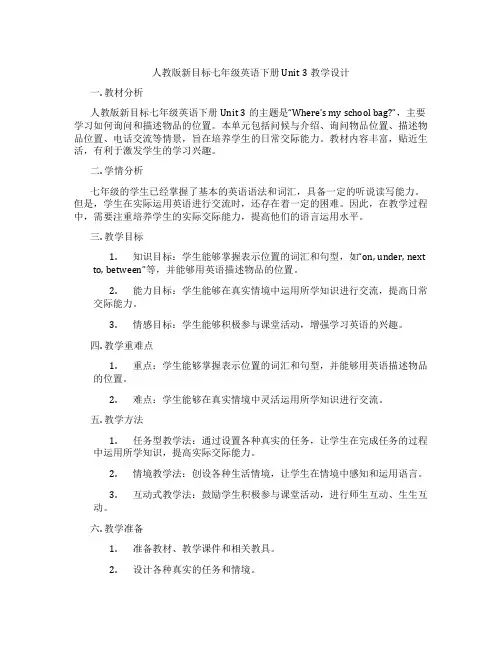
人教版新目标七年级英语下册 Unit 3教学设计一. 教材分析人教版新目标七年级英语下册Unit 3的主题是“Where’s my school bag?”,主要学习如何询问和描述物品的位置。
本单元包括问候与介绍、询问物品位置、描述物品位置、电话交流等情景,旨在培养学生的日常交际能力。
教材内容丰富,贴近生活,有利于激发学生的学习兴趣。
二. 学情分析七年级的学生已经掌握了基本的英语语法和词汇,具备一定的听说读写能力。
但是,学生在实际运用英语进行交流时,还存在着一定的困难。
因此,在教学过程中,需要注重培养学生的实际交际能力,提高他们的语言运用水平。
三. 教学目标1.知识目标:学生能够掌握表示位置的词汇和句型,如“on, under, nextto, between”等,并能够用英语描述物品的位置。
2.能力目标:学生能够在真实情境中运用所学知识进行交流,提高日常交际能力。
3.情感目标:学生能够积极参与课堂活动,增强学习英语的兴趣。
四. 教学重难点1.重点:学生能够掌握表示位置的词汇和句型,并能够用英语描述物品的位置。
2.难点:学生能够在真实情境中灵活运用所学知识进行交流。
五. 教学方法1.任务型教学法:通过设置各种真实的任务,让学生在完成任务的过程中运用所学知识,提高实际交际能力。
2.情境教学法:创设各种生活情境,让学生在情境中感知和运用语言。
3.互动式教学法:鼓励学生积极参与课堂活动,进行师生互动、生生互动。
六. 教学准备1.准备教材、教学课件和相关教具。
2.设计各种真实的任务和情境。
3.准备一些与本节课主题相关的图片、视频等资料。
七. 教学过程1.导入(5分钟)利用图片或视频引入主题,激发学生的学习兴趣。
教师可以用一些简单的问题引导学生进行思考,如“你们在生活中是怎样描述物品位置的?”等。
2.呈现(10分钟)教师通过展示图片或实物,引导学生学习表示位置的词汇和句型,如“on, under, next to, between”等。

第四课时Section B (2a—3b)教学目标通过本课的学习,学生能够:1.获取和梳理本课语篇的信息和涉及的what、how、why句型的关键信息;理解并掌握本课时重点词汇,如cross、river、village、bridge、between…and…等。
(获取信息)2.使用速读、寻读和思维导图的阅读策略对语篇信息进行结构性梳理,并在语境中正确理解和区分词性。
(梳理整合)3.深层思考亮亮上学方式变化的原因,并清楚阐述自己的观点,提高自身思维品质。
(内化应用)4.借助小组活动,合作探究的方式,懂得珍惜自己的生活和学习条件,从而更努力地学习。
(迁移创新)语篇研读What:本语篇介绍了一个偏远乡村孩子亮亮上学的故事,亮亮出生于偏远山区,上学方式艰辛,但他毫无畏惧,热爱校园,热爱老师,热爱学业。
Why:这一题材展现了偏远地区孩子上学的艰苦,目的是为了唤起城市孩子的关注,同时让他们懂得珍惜自己的生活和学习条件,从而更努力地学习。
How:2a在培养学生的预测能力,2b侧重于语篇信息理解,2c活动则利用句子填空的方式来强化、巩固对阅读内容的理解。
教学过程设计理念:以《英语课程标准》核心素养为导向,以单元主题为引领,基于语篇的育人理念,体现《英语课程标准》“学思用创”的英语学习活动观和“教—学—评”一体化设计理念。
板书设计作业设计基础型作业:Read and recite the key words, phrases and sentences in the class.实践型作业:Finish and polish your passage after class.拓展型作业:Search how children in the world get to school on the Internet and makea report.教学反思。
七年级英语下册Unit3 How do you get to school?
Section B(2a—2c)
课程设计
【设计思想】
本单元的核心教学内容是谈论学生上学的交通方式。
要求通过学习有关的短语及句型能够训练学生捕捉细节信息的能力和叙述复杂事情的能力。
教学目标
知识目标(1)重点词汇
(2)学会解决阅读题的答题方法
技能目标(1)培养学生的预测能力
(2)训练学生的理解水平
(3)训练学生的语言知识的学习-对形容词、副词的学习与巩固。
情感态度价值观(1)学习内容贴近生活,易激发学生学习英语的兴趣,使他们乐于参与各种英语实践活动。
(2)培养同学们之间互相帮助、团结友爱的精神。
教学重点、难点
重点:利用语境学习生词。
难点:熟练掌握本单元与交通出行相关的词汇和表达。
采用Discussion 的学习策略,利用课件等来展开课堂的形式predict what’s the passage about ,read and translate it 。
教学步骤。
Unit 3 How do you get to school?Learning Objectives一、Topics(话题):Transportation二、Functions (功能)Talk about how to get to places三、Structures (结构)1. How questions2. How long questions3. How far questions四、Target Language (目标语言)How do you get to school?I ride my bike.How long does it take to get to school?It takes about 20 minutes.How far is it from your home to school?It’s about two kilometers.五、V ocabulary (词汇)train, bus, subway, bike, car, boat, river, year, minute, kilometer, sixty, seventy, eighty, ninety, hundred, ride, drive, live, leave, cross take the train/bus, go by bike/subway, ride a bike, drive a car, think of, between … and …, leave home/school, come true六、Skills (技能)Listening for key informationScanning in reading七、Recycling (复习巩固)Numbers 1–30I usually …It is easy to …Thanks for …八、教材分析本单元以How do you get to school?为中心话题,主要运用How long/How far 询问“去某地的交通方式、时间、距离”,简单描述路线。
A TEACHING PLAN FOR AN OPENING CLASSUnit 3 Why do you like koalas?Teaching aims and demands:1. Aims of basic knowledgeAnimals:tiger ,elephant ,koala ,dolphin ,panda ,lion ,penguin ,giraffe and so on.Some adjectives about character:cute ,smart ,interesting,fun and so on Target languages: Why do you like koalas? Because they are cute.2. Aims of abilities:Describe animalsExpress preferences3. Aims of Emotion:(1). Train the students to protect animals consciously.(2). Love nature, life and more.(3). Help each other actively.Important points and difficult points:1.Master the vocabularies of animals.2.Discuss the reason why you like it best.3.kind of and very.Learning strategies:active cooperation, study by using what you know and inferring contentTeaching steps:Lead-inShow students a short film of an animal on the screen and ask: Do you know this animal? Is it smart? Then describe it simply. Say: If you want to know more animals, please follow me to the zoo. Let’s start Unit 3.(The aim of this part is to arouse the students’ interest and get ready for the new learning material.)Task1. Get familiar with the animalsStep1. Let the students say as many animals they’ve learnt as they can quickly.Step2. Look at the animals on the screen. What is this? It is a panda. It’s very cute.Repeat with other animals, such as tiger, elephant, lion and so on.Step3. 1a. Match the words with the animals in the picture.S t e p4.1b.L i s t e n a n d c h e c k t h e a n i m a l s y o u h e a r.(T h e a i m o f t h i s t a s k i s t o h e l p t h e s t u d e n t s g e t f a m i l i a r w i t h t h e a n i m a l s a n d d e v e l o pt h e i r l i s t e n i n g a b i l i t y.)Task2. Talk about your favorite animals with some adjectives:Step1.Show a video of some dancing penguins on the screen and ask the students:Do you like penguins?Then ask students to ask and answer which animals they like in teams.--Do you like penguins?--Yes, I do. / No, I don’t.Check which team can do it most quickly.Step2. PairworkAsk about your partners’ favorite animals and reasons in groups.Eg. A: Do you like penguins?B: Yes, I do.A: Why?B: Because they’re cute.Ask some pairs to act out their conversations.(The aim of this task is to develop the students’communicative and cooperation competence)Task 3.Visit the zooStep1. Know what animals Julia and Henry want to see.2a Listen. Write the animals you hear. Draw a line from the animals to thedescription words.2b.Listen and complete the conversation with the words in the box.Step2. Suppose you and your friends are in the zoo. Ask your friends the following questions:What animals do you want to see first?Why do you like them?Make conversations in groups.(The aim of this task is to develop the students’abilities of collecting and using information.)Task4. Play games (Challenge extreme limit)Do some challenges.Divide the class into groups and see which group can be the winners.Challenge1. Use the pictures to test the students’ memories.Challenge2. Let the students use correct adjectives to describe different animals. Challenge3. Answer the questions quickly.(The aim of this task is to let the students practice using the target language and give them an emotional education.)SummaryDuring this lesson, we have learnt some names of the animals, how to describe your favorite animals and why you love them. The animals are our good friends. We should love them and protect them. Now let’s watch a short film and listen to a sweet song. HomeworkWrite a conversation about visiting the zoo.教学反思The aim of this lesson is to improve the students’ abilities of listening and speaking. In order to help the students have a better effect in collecting and using the information, I design some tasks for the students and let them achieve the tasks with the help of the CAI, computer and recording. I try to give the students a real language situation using the modern teaching aids. Let them improve their English from watching, listening, and speaking in a relaxed and pleasant atmosphere. I think they can communicate with each other easily.。
Unit 3 How do you get to school?Section A (1a-2d)一、教学目标:1. 语言知识目标:1) 能掌握以下单词:train, bus, subway, ride, bike, sixty, seventy, eighty, ninety, hundred, far, minute, kilometer, new, every, every day2) 能掌握以下句型:①—How do you get to school? —I ride my bike.②—How does Mary get to school? —She takes the subway.2. Talk about how to get to places (谈论出行方式)take the bus /subway /train /taxi , ride a bike /walk .3. how引导的特殊疑问句,表示乘坐何种交通工具的方式。
how far, how long 引导的特殊疑问句。
4. 复习基数词及时间的表示方法。
2. 情感态度价值观目标:让学生感受到他们学习英语是为了在现实生活中进行交流,而不单纯是为了英语课和应付考试而学习,了解东西方国家出行方式的不同,以及不同的交通规则,教育学生注意交通安全, 加深对交通知识的了解。
倡导自觉遵守交通法规及礼貌,构建和谐的人际关系。
了解交通的发展,培养创新精神。
二、教学重难点1. 教学重点:1) how /how far /how long 引导的特殊疑问句.2) 乘坐交通工具的表示方法.3) It takes / sb some time to do sth .2. 教学难点:—How do you get to school? —I take the …/ride …/ walk…—How does Mary get to school? —She takes the subway.—How long does it take? —It takes forty minutes.—How far is it from… to…—It's… kilometers.三、教学过程Ⅰ. Warming-up and Lead in学生和老师进行简单的问候Ss : Good morning , teacher.T: Good morning , classT: Look at the picture. What can you see? Do you like your school? I usually get to school by bike, but sometimes on foot . How do you get to school?Ss 按实际情况作答Ⅱ. Presentation1. T: If you are here, but your school is in Shanghai. How do you get to school?Ss: I take the bus /plane/ boat / ship / car / taxiI ride a bike / motorbikeT: Do you know any other way?2. Teacher shows pictures on the big screen .归纳出行方式和常用短语.Ask some questions about how you get to…?(让学生积极主动的思考想象总结,多媒体增加趣味性,加强直观性,效果事半功倍)3. Show a picture about Part 1, on the screen.Point at girls or boys in the picture.Ask students to answer and write in the blanks.S1 : How does he / she go to school?S2 : He / She … …Ⅲ. 1aT: Look at the picture on your book. Match the words with the picture.(学生们完成1a的学习任务,然后校对答案)Ⅳ. Listening1. Make sure the Ss know what to do. Give them an example orally if possible.2. Read the names in the box.3. Play the tape and check the answers.Ⅴ. Pair workAsk two students to read the dialogue in the speech bubbles to the class. Then ask students to work in pairs. Ask and answer how students get to school in the picture.Finally ask some pairs of students to present their conversations to the class.Ⅵ. Listening1. Revise the numbers, first, zero~nine, next, ten~nineteen, then, twenty, thirty,forty…finally, twenty-one, twenty-two…Teach the new word "hundred".2. Play the tape for the students to finish 2a. Then play again and check the answers Ⅶ. PresentationShow a picture on the TV and explain these are your home and school.Teach: home----school How long 10 minutes How far two kilometersThen make up a dialogue to practice.A: How do you get to school?B: I usually take the bus.A: How far is it from your home to school?B: It's about two kilometers.A: How long does it take?B: It takes 30 minutes by busⅧ. Listening1. Tell Ss the following recording is about how Tom and Jane go to school.2. First, listen to the recording fill in the first column.3. Then, play the recording for the Ss again. Ss listen and complete the rest of thechart.4. Check the answers.Ⅸ. Role-play1. Read the dialogue and find the answer to these questions:①How does Jane get to school?②How far is it from home to school?③How long does it take to get to school from her home?2. Ss read the conversations and then find the answers to the questions.3. Check the answers with the class.4. Play the recording for the Ss to listen and repeat.5. Ss read the conversation then role-play the conversation.6. Let some pairs act out the conversation.Homework1. Remember the new words and expressions in this period.2. Role-play the conversation after class.板书设计:Section A (1a-2d)1. —How do you get to school? —I ride my bike?—How does Mary get to school? —She takes the subway.2. 表达“几十” 个位数字+ty twenty, thirty,表达“几十几” 一定要用连字符twenty-five, sixty-ninehundred one hundred, two hundred3. ① How does Jane get to school?② How far is it from home to school?③ How long does it take to get to school from her home?教学反思Section A (Grammar Focus-3c)一、教学目标:1. 语言知识目标:1) 继续练习谈论出行方式take the bus /subway /train /taxi, ride a bike /walk .2)用不同方式练习how引导的特殊疑问句,表示乘坐何种交通工具的方式。
how far, how long 引导的特殊疑问句。
3)复习基数词及时间的表示方法。
2. 情感态度价值观目标:了解东西方国家出行方式的不同,以及不同的交通规则,教育学生注意交通安全, 加深对交通知识的了解。
倡导自觉遵守交通法规及礼貌,构建和谐的人际关系。
了解交通的发展,培养创新精神。
二、教学重难点1. 教学重点:1) how /how far /how long 引导的特殊疑问句.2) 乘坐交通工具的表示方法.3) It takes sb some time to do sth .2. 教学难点:—How do you get to school? —I take the …/ride …/ walk…—How does Mary get to school? —She takes the subway.—How long does it take? —It takes forty minutes.—How far is it from… to…—It's… kilometers.三、教学过程Ⅰ. Warming- up and revision1. Greet the Ss as usual. Then check the homework.2. Go over the conversation in 2e.Ⅱ. Grammar Focus.1. 学生阅读Grammar Focus中的句子,然后做填空练习。